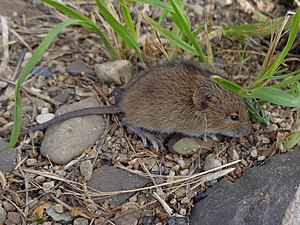Birch mice
| Birch mice | ||||||||||||
|---|---|---|---|---|---|---|---|---|---|---|---|---|

Forest birch mouse ( Sicista betulina ) |
||||||||||||
| Systematics | ||||||||||||
|
||||||||||||
| Scientific name of the family | ||||||||||||
| Sminthidae | ||||||||||||
| Brandt , 1855 | ||||||||||||
| Scientific name of the genus | ||||||||||||
| Sicista | ||||||||||||
| Gray , 1827 |
The birch mice ( Sicista ) or striped hop mice are a genus of mouse relatives (Myomorpha).
features
All species have a long tail 6.5–11 cm long and weigh about 6–14 g. The length of the head body is between 5 and 9 cm. The coat color is light brown or dark brown to brownish-yellow on the top and paler, but mostly also brownish, on the underside.
Way of life
The different species of birch mice can be found in different habitats such as forests, steppes, swamps, moors and subalpine meadows. They live in self-dug caves whose nest chambers are padded with dry grass and plant stems. They hop on the ground and are also able to climb branches. The animals are nocturnal .
species
The genus of the birch mice ( Sicista ) consists of 14 species:
- Armenian birch mouse ( Sicista armenica ) northwest Armenia
- Forest birch mouse ( Sicista betulina )
- Caucasian birch mouse ( Sicista caucasica ) North Caucasus, West Caucasus and Armenia
- Long-tailed birch mouse ( Sicista caudata ) Ussuri region of Manchuria and southern Siberia, Sakhalin
- Chinese birch mouse ( Sicista concolor ) north of Pakistan and Kashmir to the mountains of Gansu and Sichuan in central China
- Kazbek birch mouse ( Sicista kazbegica ) Georgia
- Kluchor birch mouse ( Sicista kluchorica ) North Caucasus
- Altai Birch Mouse ( Sicista napaea ) Northwestern Altai Mountains in south central Siberia
- Sicista nordmanni (Keyserling and Blasius, 1840)
- Gray birch mouse ( Sicista pseudonapaea ) southern Altai Mountains in Kazakhstan
- Beach birch mouse ( Sicista strandi ) Kursk and Caucasus regions in southern Russia
-
Steppe birch mouse ( Sicista subtilis )
- Subspecies Severtzov birch mouse ( S. subtilis severtzovi ) Voronezh region in southern Russia
- Tianshan birch mouse ( Sicista tianshanica ) Tianshan Mountains
- Sicista trizona (Frivaldszky, 1865)
Sicista betulina and Sicista subtilis differ from the other species by a conspicuous black line that runs along the middle of the back.
Systematics
The birch mice were long considered a subfamily of the jerboa (Dipodidae), although they have no elongated hind legs and externally resemble real mice , although it is assumed that they are at the base of the jerboa. In the Handbook of the Mammals of the World , a standard work on mammalogy , they are treated as separate families.
threat
The species Sicista armenica is classified as critically endangered by the IUCN . It is estimated that only about 250 animals are still alive. Sicista caudata is considered endangered due to habitat destruction . The forest birch mouse ( Sicista betulina ) and the steppe birch mouse ( Sicista subtilis ) are both considered to be at low risk despite their large distribution areas. The reason is probably their relatively special habitat requirements.
literature
- David Macdonald (Ed.): The Great Encyclopedia of Mammals. Könemann in the Tandem-Verlag-GmbH, Königswinter 2004, ISBN 3-8331-1006-6 .
- Ronald M. Nowak: Walker's Mammals of the World. 2 volumes. 6th edition. Johns Hopkins University Press, Baltimore MD et al. 1999, ISBN 0-8018-5789-9 .
- Detlef Schilling, Detlef Singer: Mammals. 181 species of Europe (= BLV determination book. Vol. 34). BLV-Verlagsgesellschaft, Munich et al. 1983, ISBN 3-405-12846-3 .
- Lexikon-Institut Bertelsmann (Hrsg.): The modern animal dictionary. In 12 volumes. Volume 10: Seeh - Tam. Bertelsmann, Gütersloh 1981, ISBN 3-570-06790-4 , pp. 267-268: Streifenhüpfmaus.
Individual evidence
- ↑ a b Don E. Wilson , Thomas E. Lacher, Jr, Russell A. Mittermeier : Handbook of the Mammals of the World: Rodents II. Volume 7. Lynx Edicions, 2017, ISBN 978-84-16728-04-6
- ↑ Tamás Cserkész, Mikhail Rusin, Gábor Sramkó: An integrative systematic revision of the European southern birch mice (Rodentia: Sminthidae, Sicista subtilis group). Mammal Review, December 2015, doi: 10.1111 / mam.12058
- ↑ Don E. Wilson, DeeAnn M. Reeder (Ed.): Mammal Species of the World. A taxonomic and geographic Reference. 2 volumes. 3. Edition. Johns Hopkins University Press, Baltimore MD 2005, ISBN 0-8018-8221-4 .